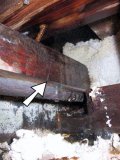
Why Is My Basement Damp?
The source of your problem could be a water leak or high humidity. Both can lead to mold, mildew, or other biological growth. Depending on the severity, conditions can lead to rot, structural damage, premature paint failure, and a variety of health problems. Water can seep into your house from the outside through a leak in the foundation, or small gaps around windows or doors. Water can also come from inside your house from a leaking water pipe, toilet, shower or bathtub. High indoor humidity caused by normal activities of everyday living, such as showering, cooking, and drying clothes, can also be a source of your problem. A damp basement is commonly caused by moisture migrating through a concrete foundation. There may not be a sign of any leak or standing water, but the moisture evaporates, increasing indoor humidity. Another common cause is condensation on the cold concrete walls and floors during humid months.
What Should I Do?
- Where does the problem occur? Below a bathroom? Ceiling? Corners? Where the problem occurs can lead to what is causing the problem. If the problem is localized (a spot on the ceiling, wall or corner it is possibly caused by a water leak. If the problem is in a large area, like a whole wall or room, then it might be caused by humidity.
- If you suspect a mold problem consult EPA's Brief Guide to Mold in your home for more information.
- If you plan to remodel your basement, it is important to control moisture problems before doing anything else. Corrective actions can be relatively easily but sometimes, depending on the severity of the problem, they can be difficult and expensive.
Stop water leaks
- If a leak is the source of your problem, have it fixed first.
- If you have standing water on the floor of your basement after a heavy rain then it is likely from a leak in the foundation.
- Clean rain gutter and redirect downspout runoff away from the foundation.
- Make sure the ground around the house slopes down away from the foundation. If necessary, re-grade so the ground does slopes away.
- If you have a sump pump, make sure it is working properly.
- If you have water stains on the ceiling or wall under or near a bathroom it could be a leak from a water pipe, toilet, bathtub or shower. Hire a plumber to repair the leak.
- If the leak has caused substantial water damage or mold you will want to hire a contractor who specializes in mold remediation and water damage repairs.
Reducing indoor humidity
- If your basement has a dirt floor, cover the floor completely with plastic to slow down water vapor coming through the soil.
- Use ventilation fans in kitchens and baths to control moisture. Check to make sure ventilation fans are venting directly outside. In some cases the vent fan may have been installed to vent into the attic or become disconnected or blocked.
- Your clothes dryer should be vented directly to the outside. Inspect the vent duct. Make sure it is attached securely to the dryer. Check that it is clear of obstructions (e.g. lint). Check for holes that leak air. If vent duct is damaged replace it with a metal duct. The vent duct should be cleaned at least once a year. The Consumer Products Safety Commission has additional safety tips for dryer vents.
- Ask a heating and cooling contractor to check your heating and cooling system to make sure it is sized and operating properly to remove humidity. If you system is too big or the airflow is incorrect your air conditioner will not remove humidity like it should. Also, ask the contractor to check your duct system for air leaks, and proper size and air flow to each room.
- Sealing air leaks (Home Sealing) and sealing duct air leaks can help to prevent high humidity levels in your home.
- During hot humid months, using a dehumidifier in the basement can reduce condensation on the walls. This may work better after you've sealed air and duct leaks to reduce the amount of humid outdoor air you are bringing into the basement.
 Print
Print Email
Email







